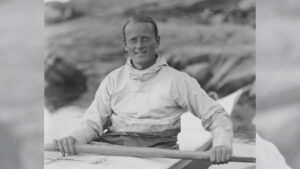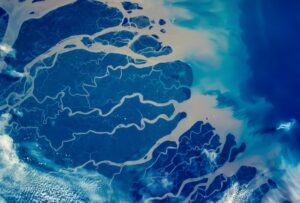Louise Arner Boyd became an unexpected candidate for arctic exploration during an era when women’s roles in the United States were changing but still rooted in tradition. Using her inheritance, she funded critical expeditions for the U.S. government and became the first woman to fly over the North Pole. She challenged the narrative in which women figured mainly in the romantic escapades of men.

Louise Boyd spent her considerable fortune exploring the Arctic.
When World War I ended, women — who had previously been destined to raise children and run the family home – had an opportunity to shift the stereotypes of their duties. Women were beginning to question what “suitable” career choices were. Most still found their voices in the shadows of their husbands.
For Boyd, the expectations were clear. She was born into a family of privilege. Her father had made a fortune in California’s gold rush. Boyd was raised to be a socialite, expected to meet community charity obligations and attend social events, then get married. But even as a child, she preferred running around with her two brothers, camping, and horseback riding.
Beginning with minor excursions, Boyd quenched her travel thirst during a period spent nursing in Europe during the 1918-19 Spanish flu pandemic. Once, she took a train to Buffalo, New York, bought a car, and drove across modest road systems of the United States on her own. It was an almost unheard-of adventure for women of that era. Still, Boyd yearned for even greater adventures.
A family crisis
Her destiny took an unforeseen trajectory when both her brothers died of rheumatic fever in quick succession. Boyd inherited the burden of caring for her heartbroken and ill parents, who traveled around America and Europe, mostly for medical purposes. They both died when she was 33, and she became the heir to her family’s $3 million fortune, the equivalent of $40 million today. Her wealth was significant but not boundless.
At first, she dutifully kept up the family’s reputation in California high society, serving as a gracious hostess and generous benefactor. Meanwhile, she chafed for a more adventurous lifestyle, as she had as a child.
She soon returned to Europe on leisure trips. When she saw snow for the first time on a 1924 cruise in Norway, she was smitten.

Boyd purchased Roald Amundsen’s old supply ship for her early recreational voyages.
She was set to return to Norway on Hobby, a supply ship previously owned by Roald Amundsen that she’d purchased when the shocking news broke that Amundsen had disappeared. He’d been searching by plane for the missing Italian explorer Umberto Nobile.
Searching for Amundsen
Wasting no time, Boyd funded a volunteer search mission with her ship. She scoured the Arctic Ocean but turned up nothing. Nobile eventually turned up, but Amundsen had vanished. Nevertheless, Boyd’s efforts earned her Norway’s Chevalier Cross of the Order of Saint Olav. She was just the third woman to receive the accolade. When she heard that the king himself would present the honor, she reportedly hurried to Paris to buy a gown because she had only arctic clothing.
Boyd and her unconventional adventures had begun to generate newspaper attention. Her interests were astounding for a woman of that era, but reporters sought to superimpose more feminine pursuits onto her story. For Boyd, this was a continuous source of frustration.
Over the next few years, Boyd’s expeditions shifted to focus mainly on polar science. In 1931, she began a series of annual scientific expeditions to the Arctic, especially Greenland’s remote northeast coast.
Documenting the Arctic
She’d learned photography during her earlier recreational trips. Now she used it to document uncharted areas of Greenland. With an aerial mapping camera, she recorded glacial landscapes, sea ice, and land formations. These later contributed to new, detailed maps. She also surveyed ocean depths and collected plants for botanical study. Later, Boyd discovered an underwater mountain ridge in northeast Norway, between Jan Mayen and Bear Islands.
In 1934, she took a three-month journey across Poland to photograph the customs, politics, dress, and culture of Eastern Europe. The American Geographical Society printed 300 of her photos. Afterward, she was asked to represent several learned societies at international conferences in Europe.
Her intimate knowledge of the Arctic, and particularly her expertise on the fiords and glaciers of eastern Greenland, proved useful when World War II broke out. In 1941, the U.S. government’s National Bureau of Standards sent her to the Arctic to study the effects of polar magnetic fields on radio communications. The mission was so secret that even her ship’s crew was not informed of it. A woman, it was thought, would surely not have the academic prowess for projects beyond mere photography. Boyd even funded the whole project herself.
She was now the Bureau of Standards’ leading expert consultant. She also worked on secret assignments for the U.S. Army.
By the time the war ended, Boyd had amassed an extensive list of honors. She was the second woman to receive the Cullum Medal of the American Geographical Society. In 1960, she became the first woman elected to its board. She received honorary law degrees from the University of California, Berkeley and from Mills College. She became an honorary member of the California Academy of Science.
The North Pole
Now in her late 60s, Boyd funded one final arctic expedition that became one of her hallmarks.

Boyd became the first woman to fly over the North Pole.
In 1955, at the age of 68, she charted a DC-4 airplane and flew over the North Pole. The flight took 16 hours. She was the first woman to fly over the Pole.
By now, she had spent almost all her fortune and was in financial difficulties. She eventually had to sell her family home, before her death in 1972 at the age of 84.
Her legacy continues. She published The Coast of Northeast Greenland, a book about her earlier expeditions. Because of Greenland’s strategic importance, the government had asked her to pause publication until the end of World War II.

Louise Boyd Land.
An uninhabited region in East Greenland — Louise Boyd Land — was later named after her. Even today, climate researchers use her glacial photographs to compare how much the Arctic has changed in these warmer times.
Boyd never married or had children. Nor did she singlehandedly change the perspective of what a women’s “suitable” career choice should be. But Boyd did help birth a phenomenon of women in science and showed that women are capable of enduring harsh arctic conditions. Even socialites.






